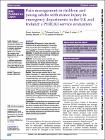| dc.contributor.author | Durnin, Sheena | en |
| dc.date.accessioned | 2022-05-06T15:15:43Z | |
| dc.date.available | 2022-05-06T15:15:43Z | |
| dc.date.issued | 2022 | en |
| dc.date.submitted | 2022 | en |
| dc.identifier.citation | Hartshorn S, Durnin S, Lyttle MD, Barrett MJ, PERUKI., Pain management in children and young adults with minor injury in emergency departments in the UK and Ireland: a PERUKI service evaluation, BMJ Paediatr Open, 6, 1, 2022, e001273 | en |
| dc.identifier.issn | 2399-9772 | en |
| dc.identifier.other | Y | en |
| dc.identifier.uri | http://hdl.handle.net/2262/98555 | |
| dc.description | PUBLISHED | en |
| dc.description | PMID: 36053599 | en |
| dc.description.abstract | Background: Management of acute pain should commence at the earliest opportunity, as it has many short-term and long-term consequences. A research priority of Paediatric Emergency Research in the UK and Ireland (PERUKI) was to examine paediatric pain practices.
Objective To describe the outcomes for paediatric pain management of minor injuries presenting to emergency departments (EDs) across PERUKI.
Methods: A retrospective service evaluation was performed over a 7-day period in late 2016/early 2017 across PERUKI sites, and analysis performed using an adapted Donabedian framework. Patients under 16 years presenting with minor trauma were eligible, and data were collected on prehospital management, pain assessment, analgesia administered and injury diagnosed.
Results: Thirty-one sites submitted data on 3888 patients. There were 111 missed cases (missed rate 3.6%). The most common injuries were sprains, lacerations, contusions/abrasions and fractures. Documentation of receiving analgesia before arrival in ED occurred in 21% of patients (n=818). A pain assessment was documented in 57.5% of patients (n=2235) during their ED visit, and 3.5% of patients had their pain reassessed (n=138). Of the patients who presented in severe pain (pain score 7–10 or rated severe), 11% were reassessed. Site variability of initial pain assessment ranged from 1.4% to 100% (median 62%). The characteristics of the top quartile performing centres against the bottom quartile performing centres based on completion rate of initial pain scores were identified.
Conclusion: Pain assessment was documented in under 60% of children with minor injury, re-assessment of pain was almost completely absent, data and outcomes were missing in a substantial volume of patients, indicating that pain management and the associated outcomes have not been adequately addressed and prioritised within existing network structures and processes. | en |
| dc.format.extent | e001273 | en |
| dc.language.iso | en | en |
| dc.relation.ispartofseries | BMJ Paediatr Open | en |
| dc.relation.ispartofseries | 6 | en |
| dc.relation.ispartofseries | 1 | en |
| dc.rights | Y | en |
| dc.title | Pain management in children and young adults with minor injury in emergency departments in the UK and Ireland: a PERUKI service evaluation | en |
| dc.type | Journal Article | en |
| dc.type.supercollection | scholarly_publications | en |
| dc.type.supercollection | refereed_publications | en |
| dc.identifier.peoplefinderurl | http://people.tcd.ie/sdurnin | en |
| dc.identifier.rssinternalid | 242744 | en |
| dc.identifier.doi | http://dx.doi.org/10.1136/bmjpo-2021-001273 | en |
| dc.rights.ecaccessrights | openAccess | |
| dc.subject.TCDTag | PAEDIATRIC | en |
| dc.subject.TCDTag | PAIN RELIEF | en |
| dc.subject.TCDTag | TRAUMA | en |
| dc.subject.TCDTag | emergency medicine | en |
| dc.subject.TCDTag | pain | en |
| dc.identifier.orcid_id | 0000-0002-5109-3417 | en |
| dc.status.accessible | N | en |




